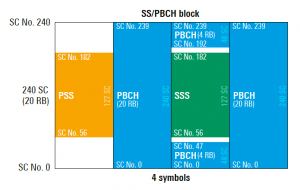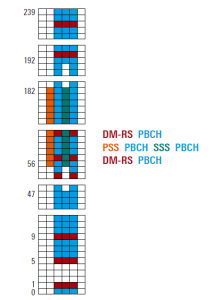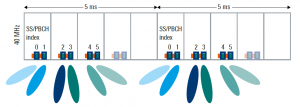In previous cellular technologies (LTE, LTE-M, NB-IoT), cell-specific synchronization and reference signals were used. Always-on reference signals were spread over the entire spectrum for precise channel estimation.
5G NR is a completely new approach regarding cell-specific signals. 5G NR only broadcasts a minimum amount of cell-specific signals with a known sequence that can be measured by a calibrated measurement receiver. All other signals are UE specific; their appearance in the frequency and time domain is related to data traffic.
The only always-on signal is the synchronization signal block (SSB). As in the below figure, each SSB occupies 240 subcarriers (frequency domain) and 4 symbols (time-domain).
It contains primary and secondary synchronization signals (PSS and SSS) and the physical broadcast channel (PBCH).
As in LTE, the PSS and SSS in 5G NR represent the physical cell identity (PCI), and the PBCH carries the master information block (MIB) plus a few additional payload bits.

If we zoom into the subcarriers, we also see demodulation reference signals (DM‑RS). The DM-RS are used by the UE for channel estimation to demodulate the PBCH. The positions of the DM-RS signals across the PBCH are determined by the PCI.

SSBs are transmitted periodically from each cell. 3GPP has defined five transmission patterns: case A to case E. The frequency range, the maximum number of SSB transmissions, the subcarrier spacing, nd the start OFDM symbols define the cases.
SSBs are organized in burst sets, with a burst set consisting of one or more SSBs. Lmax. denotes the maximum number of SSBs that can be configured for different cases. For higher frequencies, the number is significantly higher (Lmax. = 64) than for the frequency range below 1 GHz (Lmax. = 4), which reflects the need for more and smaller beams in the cm/mm-wave spectrum. Each SSB has an index with an increasing number from 0 to Lmax. – 1.
The periodicity (20 ms) can vary between 5 ms and 160 ms (5, 10, 20, 40, 80, 160 ms). The 3GPP standard recommends using a periodicity of 20 ms for cell-defining SSBs. Higher periodicities such as 80 ms or 160 ms are preferably used for SSBs in mmWave networks in order to allow more time for the transmission of a higher number of SSBs in cases D and E.

Beamforming is an essential method to overcome the increasing path loss when using higher frequencies. This is also used for the SSBs that can be individually beamformed and preferentially cover a certain geographical area.
In the following example, one cell is transmitting six SSBs (L = 6), meaning the SSB is transmitted six times, each time with a different value of the SSB index. If SSB beamforming is enabled, each SSB is transmitted on different spatial beams (here color-coded).

Source: Rohde & Schwarz White paper
For more details about, Contact moniem@newsite.moniem-tech.com
